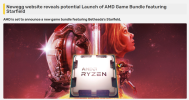Well this is what AMD had in mind all along. Nvidia invents and brings to market some proprietary innovation, builds up interest and adoption, and then AMD comes in with some open source implementation which works on everything, looking like the good guys, while simultaneously blocking people from implementing the superior product.. expecting consumers to be ok with it because it works on everything..
I rather think what AMD has in mind is to show that upscaling can be done without AI.
And if it works well enough, this proofs that we do not need AI acceleration yet, so it also proofs wrong the competitors claim of AI acceleration being worth it already now.
Because GPUs are expensive, and AI acceleration takes die area which is costly but so far is used exclusively for upscaling, gamers might decide to spend their money better on AMD to get more for the buck.
Making FSR open source helps with adoption. And blocking DLSS obviously also helps, because if FSR adoption is higher, it proofs AI isn't needed.
That's at least how i perceive it. It's basically a war of traditional programming vs. machine learning. And if upscaling is the only application, the war makes sense.
However, some time has passed by, and it has shown:
* AMD has failed or is no longer willing to offer HW at lower cost, even going without ML acceleration and chiplets. People neither buy AMD nor NV GPUs, because both are too expensive. (They don't buy Intel either, although cheap and has ML acc.)
* The ability of ChatGPT & co. has proofed a fight against AI is completely pointless. I'm happy enough if humanity as a whole does not become redundant within the next decades.
So personally i think it's time to give up the war. They better just stop blocking DLSS and focus on adding some ML acceleration to GPUs as well, beside increasing their software division.
I guess it's safe to assume ML will be used in games, not just for upscaling. If i like it or not.
What i don't like about it is that 'open source' for ML (as discussed further above) makes little sense. It would not help game devs to develop their own ML applications. The obstacle remains training data and processing infrastructure.
It feels like traditional software development will just vanish, and there is no way around AI development meant to replace it being centralized, until the development itself moves to AI.


